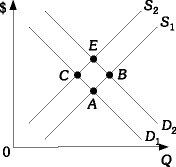An increase in the price of product A will:
A. increase the demand for complementary product C.
B. increase the demand for substitute product B.
C. reduce the demand for resources used in the production of A.
D. reduce the demand for substitute product B.
Answer: B
You might also like to view...
The three broad reasons for saving, as identified by economists, relate to:
A. the life-cycle, precaution, and bequests. B. national, public, and private production. C. capital gains, capital losses, and deficits. D. consumption, investment, and exports.
The aggregate demand curve shows the equilibrium output level at different price levels determined from the income-expenditures model
Indicate whether the statement is true or false
Refer to the information provided in Figure 3.16 below to answer the question(s) that follow. Figure 3.16Refer to Figure 3.16. When the economy moves from Point E to Point B, there has been
Figure 3.16Refer to Figure 3.16. When the economy moves from Point E to Point B, there has been
A. a decrease in supply and an increase in quantity demanded. B. a decrease in supply and an increase in demand. C. an increase in supply and an increase in quantity demanded. D. an increase in both supply and demand.
An example of a market failure is when:
A. a firm selling a product faces competition from many other sellers. B. a good is priced too high for poor families to afford. C. the distribution of surplus is unfair. D. one person's consumption of a good imposes costs on others